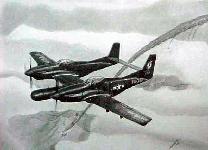




Specifications | |
| Manufacturer: | Lockheed Aircraft Corporation |
| Span: | 51 ft. 3 in. |
| Length: | 38 ft. 1 in. |
| Height: | 13 ft. 8 in. |
| Weight: | 24,800 lbs. max. |
| Armament: | |
| Engines: | Two Packard V-1650s of 1,380 hp. ea. |
| Crew: | Two |
| Cost: | $228,000 |
| Maximum speed: | 482 mph |
| Cruising speed: | 280 mph |
| Range: | 2,200 miles |
| Service Ceiling: | 39,900 ft |
